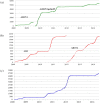On Temporal Patterns and Circulation of Influenza Virus Strains in Taiwan, 2008-2014: Implications of 2009 pH1N1 Pandemic
- PMID: 27139905
- PMCID: PMC4854472
- DOI: 10.1371/journal.pone.0154695
On Temporal Patterns and Circulation of Influenza Virus Strains in Taiwan, 2008-2014: Implications of 2009 pH1N1 Pandemic
Abstract
Background: It has been observed that, historically, strains of pandemic influenza led to succeeding seasonal waves, albeit with decidedly different patterns. Recent studies suggest that the 2009 A(H1N1)pdm09 pandemic has had an impact on the circulation patterns of seasonal influenza strains in the post-pandemic years. In this work we aim to investigate this issue and also to compare the relative transmissibility of these waves of differing strains using Taiwan influenza surveillance data before, during and after the pandemic.
Methods: We make use of the Taiwan Center for Disease Control and Prevention influenza surveillance data on laboratory-confirmed subtyping of samples and a mathematical model to determine the waves of circulating (and co-circulating) H1, H3 and B virus strains in Taiwan during 2008-2014; or namely, short before, during and after the 2009 pandemic. We further pinpoint the turning points and relative transmissibility of each wave, in order to ascertain whether any temporal pattern exists.
Results/findings: For two consecutive years following the 2009 pandemic, A(H1N1)pdm09 circulated in Taiwan (as in most of Northern Hemisphere), sometimes co-circulating with AH3. From the evolution point of view, A(H1N1)pdm09 and AH3 were able to sustain their circulation patterns to the end of 2010. In fact, A(H1N1)pdm09 virus circulated in six separate waves in Taiwan between summer of 2009 and spring of 2014. Since 2009, a wave of A(H1N1)pmd09 occurred every fall/winter influenza season during our study period except 2011-2012 season, when mainly influenza strain B circulated. In comparing transmissibility, while the estimated per capita weekly growth rates for cumulative case numbers (and the reproduction number) seem to be lower for most of the influenza B waves (0.06~0.26; range of 95% CIs: 0.05~0.32) when compared to those of influenza A, the wave of influenza B from week 8 to week 38 of 2010 immediately following the fall/winter wave of 2009 A(H1N1) pdm09 was substantially higher at r = 0.89 (95% CI: 0.49, 1.28), in fact highest among all the waves detected in this study. Moreover, when AH3 or A(H1N1)pdm09 exhibit high incidence, reported cases of subtype B decreases and vice versa. Further modeling analysis indicated that during the study period, Taiwan nearly experienced at least one wave of influenza epidemic of some strain every summer except in 2012.
Discussion: Estimates of R for seasonal influenza are consistent with that of temperate and tropical-subtropical regions, while estimate of R for A(H1N1)pdm09 is comparatively less than countries in Europe and North America, but similar to that of tropical-subtropical regions. This offers indication of regional differences in transmissibility of influenza virus that exists only for pandemic influenza. Despite obvious limitations in the data used, this study, designed to qualitatively compare the temporal patterns and transmissibility of the waves of different strains, illustrates how influenza subtyping data can be utilized to explore the mechanism for various influenza strains to compete or to circulate, to possibly provide predictors of future trends in the evolution of influenza viruses of various subtypes, and perhaps more importantly, to be of use to future annual seasonal influenza vaccine design.
Conflict of interest statement
Figures




Similar articles
-
Transmissibility and temporal changes of 2009 pH1N1 pandemic during summer and fall/winter waves.BMC Infect Dis. 2011 Dec 2;11:332. doi: 10.1186/1471-2334-11-332. BMC Infect Dis. 2011. PMID: 22136530 Free PMC article.
-
[Influenza surveillance in five consecutive seasons during post pandemic period: results from National Influenza Center, Turkey].Mikrobiyol Bul. 2016 Jul;50(3):401-17. doi: 10.5578/mb.27775. Mikrobiyol Bul. 2016. PMID: 27525396 Turkish.
-
The new pandemic influenza A/(H1N1)pdm09 virus: is it really "new"?J Prev Med Hyg. 2016;57(1):E19-22. J Prev Med Hyg. 2016. PMID: 27346935 Free PMC article.
-
Epidemiologic and virologic assessment of the 2009 influenza A (H1N1) pandemic on selected temperate countries in the Southern Hemisphere: Argentina, Australia, Chile, New Zealand and South Africa.Influenza Other Respir Viruses. 2011 Nov;5(6):e487-98. doi: 10.1111/j.1750-2659.2011.00249.x. Epub 2011 Apr 20. Influenza Other Respir Viruses. 2011. PMID: 21668677 Free PMC article. Review.
-
Transmission parameters of the A/H1N1 (2009) influenza virus pandemic: a review.Influenza Other Respir Viruses. 2011 Sep;5(5):306-16. doi: 10.1111/j.1750-2659.2011.00234.x. Epub 2011 Mar 31. Influenza Other Respir Viruses. 2011. PMID: 21668690 Free PMC article. Review.
Cited by
-
Influenza B viruses in pigs, Taiwan.Influenza Other Respir Viruses. 2019 Jan;13(1):91-105. doi: 10.1111/irv.12588. Epub 2018 Oct 27. Influenza Other Respir Viruses. 2019. PMID: 29996007 Free PMC article.
-
Construction and identification of influenza plasmid pool imparting high yields to candidate vaccine viruses in Vero cell at low temperature.J Cell Mol Med. 2020 Oct;24(19):11198-11210. doi: 10.1111/jcmm.15672. Epub 2020 Sep 9. J Cell Mol Med. 2020. PMID: 32902192 Free PMC article.
-
An Epidemiological Analysis of Summer Influenza Epidemics in Okinawa.Intern Med. 2016;55(24):3579-3584. doi: 10.2169/internalmedicine.55.7107. Epub 2016 Dec 15. Intern Med. 2016. PMID: 27980256 Free PMC article. Review.
-
Containing influenza outbreaks with antiviral use in long-term care facilities in Taiwan, 2008-2014.Influenza Other Respir Viruses. 2018 Mar;12(2):287-292. doi: 10.1111/irv.12536. Epub 2018 Jan 28. Influenza Other Respir Viruses. 2018. PMID: 29341490 Free PMC article.
-
Retrospective Epidemiological Analysis of Influenza A Infections in a Single Hospital in Korea (2007-2024): Age, Sex, and Seasonal Patterns.Pathogens. 2025 Mar 14;14(3):282. doi: 10.3390/pathogens14030282. Pathogens. 2025. PMID: 40137767 Free PMC article.
References
-
- World Health Organization. WHO Media Centre: Influenza (Seasonal) March 2014. Available: http://www.who.int/mediacentre/factsheets/fs211/en/, last accessed May 8 2015.
-
- Taiwan Center for Disease Control and Prevention (TCDC). Taiwan National Infectious Disease Statistics System: Influenza. Available: http://nidss.cdc.gov.tw/en/Default.aspx?op=2, last accessed May 8 2015.
-
- Retailliau HF, Gale JL, Beasley RP, Hattwick MA. Excess mortality and influenza surveillance in Taiwan. Int J Epidemiol. 1978;7: 223–239. - PubMed
-
- Simonsen L. The global impact of influenza on morbidity and mortality. Vaccine. 1999;17: S3–10. - PubMed
Publication types
MeSH terms
LinkOut - more resources
Full Text Sources
Other Literature Sources
Medical

